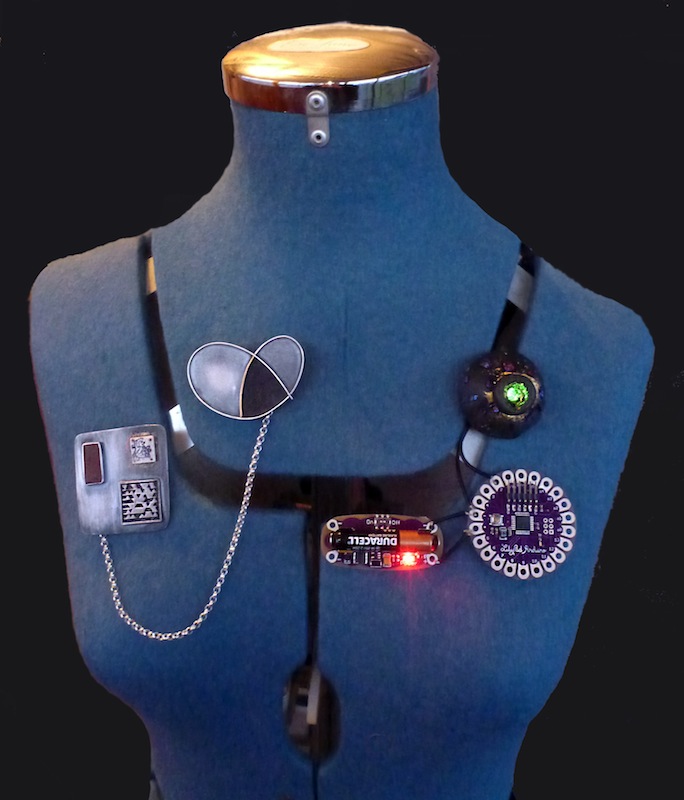Emma Bugg (AUS)

Emma Bugg explores the possibilities technology offers to the realm of jewellery. In one of Emma's NAF:TMFC response works, the Love Brooch, she invited people to share their photos of hearts found in everyday places, thus building the love content on the brooch. Audiences were invited to engage with the brooch via Facebook and Instagram (see #LBPHEART tag). The brooch has a QR code embedded that directs the onlooker to a growing collection of found hearts online. Designed to be worn over the heart, the wearer absorbs the love by osmosis. Effectively networking the body through jewellery.
An unexpected but warmly welcomed consequence of the Love Brooch was a growing perception for hearts in places. As a virus, participants kept seeing and sharing more and more hearts.
In addition Emma expanded on the Love Brooch, building a second brooch holding a Lilypad circuit that was able to monitor the heart rate of the person wearing the brooch
Emma Bugg is based in Tasmania and uses concrete and demolition site rubble in her jewellery with the aim of subverting our perception of this industrial material - from the grand scale of a building, reduced to the size of (remove a) jewellery (remove object) that can be effortlessly carried around by the body. Concrete becomes surprisingly lightweight and elegant at this intimate scale.
Placing concrete alongside precious metals and stones challenges the value we place upon this material. In the form of a building, it is valued highly, but when a building is demolished and the material is taken out of context, all that is left is worthless rubble.
The jewellery becomes a vessel that is embedded with a story of a place that once existed, often having a sentimental connection to the wearer. Emma's work investigates the use of modern storage devices and codes to add another level of meaning for the wearer, and becomes the contemporary interpretation of a traditional locket.
Responding Artist
The Love Broach
http://buggemma.wix.com/thelovebroochproject
Artist Text Response
I have to admit that when I first heard the title of the Tactical Magick Fairie circuit workshop, I was slightly perturbed, but knowing Nancy and Pip, I knew there would be more to what they were proposing than rainbows, auroras and faerie sparkles…*
Day one began with us sitting in the darkened space of CAST gallery with a whole bunch of glowing white apple logos from the Mac book of the people opposite (apart from Jason James, who had a different type of stealth black laptop). We went around and introduced ourselves in a few words. The common thread was that we were all involved in some form of arts based practice, from sound art to traditional crafts, and we all had an interest what we could filter and apply to our own practice from techno gurus we were exposed to throughout the duration of the program.
The three-day intensive workshop began with Julian Oliver and Danja Vasiliev, who described the Internet as “A deeply misunderstood technology upon which we increasingly depend.” They explained how the Internet can be used to hack hotel WiFi, legislation regarding privacy breeches, and some of the projects they have worked on.
We learned how to create a simple network that runs on Linux, and can operate offline. This was my first experience of anything like this, and although I found it difficult to keep up, I got the gist of its purpose and found it totally fascinating.
The first glimpse of how I saw myself fitting into this experience in the workshop context was when Danja explained how a goldsmith had made some of the components for their grenade. There was also mention of how computer components and jewellery were made of the same stuff of the earth, the precious nature of jewellery versus the disposable nature of computers.
After lunch, we piled into a maxi-taxi and headed to the art school for a forum with Florian Cramer. On the way, we joked about that plane crash where those unfortunate kids with genius abilities died, and with the reckless driving of the taxi driver we thought we might be next, thus depriving the world of techno artists. Florian, amongst many other riveting things, explained how the K in ‘magick’ came to be.
In response to the information we were pleasantly bombarded over the duration of three days, I wanted to make a brooch that incorporated Darwin glass, said to hold magical properties. This plan changed as discussions evolved around it. Exploration of what other types of technology (besides QR codes which I’ve used in the past) exist that could be adapted to jewellery.
My concern was that I didn’t want the piece to look like an unattractive techno-object. I set out to make a piece that responds to the body in some way, and that holds some kind of secret to the wearer, but also considers aesthetics of design and beauty.
At the first crit session, my colleagues offered suggestions and the one I chose to investigate further was the Lilypad Arduino; a small programmable computer intended for use in the textiles industry. The design of these computer objects considers beauty and they have a feminine aesthetic. As the name makes reference to the botanical, they look like a flower. Aw.
This is where I am at with the next stage of jewellery that responds to the body, monitoring and graphing results to see if there are any physiological changes when particular stones with healing properties are worn with these results built into and accessed via the jewellery object.
Overall, it was an overwhelmingly magical experience. I feel lucky to have been a part of it, and I highly recommend everything about it. I loved how we were exposed to international professionals. We were privy to some incredible minds, and amongst it all there was still time for adventures and fun, where the most precious thing of all was hatching new friendships and nurturing existing ones.
*As it turned out, all of the above were included.

The Love Brooch set
Photo Emma Bugg